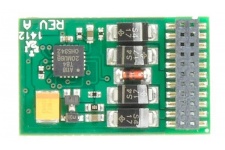Class 20 D8011 BR Green Small Yellow Panel Indicator Disks
Built: 1957 - 1968
Constructed by: English Electric
Duties: mixed traffic
Model Highlights
• Sprung buffers
• Route indicator discs
History
The British Railways Board's 1955 modernization plan called for a change to alternative forms of traction and manufacturers were asked to produce trial or initial designs for evaluation. English Electric adapted an existing design based on an export model for a 1000 bhp diesel and 20 were built as a pilot scheme for assessment.
The first batch was built in 1957 and the diesels were assigned to work from Devon's Road depot, East London. The design was a success from the start and by 1962 a total of 127 had been built. Following assessment of all the Type 1 diesels, BRB placed a further order increasing the total to 228 by 1968 and the design became the BR standard for 1000 bhp diesel locomotives. With the introduction of the TOPS code system in 1968 the diesels were designated Class 20 and renumbered 20 001 to 20 228. The locomotives were principally designed for freight work but also saw service on summer passenger trains where train heating was not required. The Class 20's worked over the Eastern, London Midland and Scottish regions as well as into Wales and were commonly associated with coal traffic. The only drawback the diesel has is a single end cab, unlike modern designs that have a cab at each end. BR resolved this problem by operating the diesels as pairs, nose to nose, and with the combined power of 2000 bhp they were able to haul the heavier block freight trains.
BR's decision to switch to Type 5 and in particular Class 60 diesels in the late 1980s started a gradual withdrawal of the fleet with just 28 left by 1994. A tribute to the design is that after 45 years the Class is still in service with DRS on mainline duties and at least 28 of the class are now preserved.
This model can be used with the Bachmann 36-557 DCC decoder.
It can also use the S0172-21 sound decoder.



